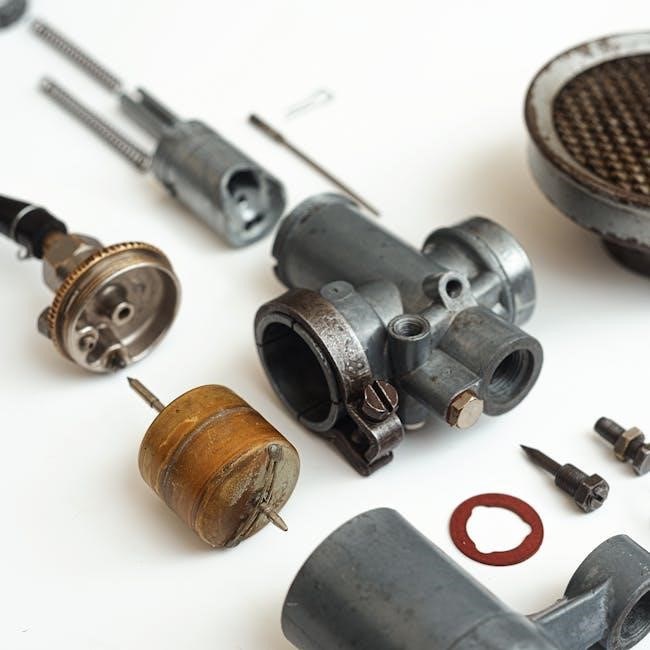Welcome to the Lesco Z Two parts manual, your essential guide for maintaining and troubleshooting this reliable mower. This manual provides detailed diagrams and repair tips.
1.1 Overview of the Lesco Z Two
The Lesco Z Two is a top-tier mower engineered for demanding landscapes. Its 54-inch deck and zero-turn capability offer unparalleled maneuverability and efficiency. Designed with the user in mind, it features an intuitive control system and a comfortable operating platform. The mower’s robust build ensures longevity, while its accessible maintenance features simplify upkeep and ensure optimal performance season after season. Ideal for both commercial and residential settings, the Lesco Z Two combines power, precision, and reliability to tackle tough mowing tasks effortlessly.
1.2 Importance of the Manual
The Lesco Z Two parts manual is an essential resource for owners and operators, providing critical information for maintenance, troubleshooting, and repairs. It ensures proper usage and care, helping to maintain the mower’s performance and longevity. With detailed diagrams and step-by-step instructions, the manual empowers users to identify and resolve issues efficiently. Regular maintenance, as outlined, prevents costly repairs and extends the lifespan of the equipment. Whether addressing blade issues, hydraulic systems, or electrical components, this guide is indispensable for keeping the Lesco Z Two in optimal condition. It serves as a comprehensive reference, ensuring safety, productivity, and reliability for years of service.

Parts Identification
This section helps users identify key components of the Lesco Z Two, including mower decks, hydraulic systems, and electrical parts, using diagrams and model numbers for clarity.
2.1 Understanding Model Numbers
The Lesco Z Two model number is a unique identifier that provides essential information about the mower. Typically, the model number is a combination of letters and numbers, such as Lesco 54 Z-Two 722321, where each part represents specific features or configurations. The first part identifies the brand and model series, while the numbers indicate the deck size, engine type, and production details. Understanding the model number is crucial for ordering correct replacement parts and ensuring compatibility. Always refer to the model number listed on the mower’s identification plate or in the original documentation when searching for components or assistance.
2.2 Key Components of the Lesco Z Two
The Lesco Z Two mower features several key components essential for its operation. The mower deck is the cutting chamber, available in sizes like 54 inches, and is equipped with adjustable blades. The engine powers the mower, typically a reliable gasoline-powered unit. The hydrostatic transmission allows for smooth speed control, while the blade clutch engages and disengages the cutting blades. Other critical parts include the control panel, steering levers, and wheels. Understanding these components is vital for proper maintenance and troubleshooting. Familiarizing yourself with their locations and functions will help ensure optimal performance and longevity of your Lesco Z Two mower.

2.3 How to Read the Parts Diagram
Reading the parts diagram for the Lesco Z Two requires attention to detail. Each component is labeled with a number or letter, corresponding to its description in the parts list. Reference numbers are often color-coded or grouped by mower sections. Pay attention to callouts for assemblies, such as the mower deck or engine. Diagrams may include exploded views to show how parts fit together. Use the index to locate specific items quickly. Understanding the diagram is crucial for identifying and ordering replacement parts. Always cross-reference with the manual to ensure accuracy. This skill is essential for effective maintenance and repair of the Lesco Z Two.

Maintenance Schedule
Regular maintenance ensures optimal performance of the Lesco Z Two. Schedule includes pre-operation checks, lubrication, blade sharpening, and hydraulic system inspections. Follow guidelines for extended equipment life.
3.1 Pre-Operation Checks
Before each use, inspect the Lesco Z Two for damaged or worn parts. Check the mower deck for debris and ensure all bolts are tightened. Verify hydraulic fluid levels and look for leaks. Ensure the blades spin freely and are properly secured. Test the clutch and brake systems for proper function. Check tire pressure and ensure all safety features, like the operator presence system, are working. Refer to the manual for specific torque values and lubrication points. Regular pre-operation checks help prevent unexpected breakdowns and ensure safe, efficient mowing. Always wear protective gear during inspections and operation.
3.2 Lubrication Points and Maintenance
Regular lubrication is crucial for the Lesco Z Two’s longevity. Grease the hydraulic system’s pivot points every 50 hours to maintain smooth operation. Apply lithium-based grease to the mower deck’s spindle housings monthly. Lubricate the blade pivot pins and idler arms quarterly to prevent wear. Check the hydraulic fluid level daily and top it off as needed using the recommended fluid type. Inspect grease fittings for damage and clean them before applying grease. Proper lubrication reduces friction, prevents overheating, and ensures optimal performance. Refer to the manual for specific lubrication intervals and compatible grease types to avoid damaging the equipment.
3.3 Blade Maintenance and Sharpening
Proper blade maintenance ensures optimal cutting performance and extends the life of your Lesco Z Two. Inspect blades regularly for damage, nicks, or wear. Tighten blade bolts to the specified torque to prevent vibration. Sharpen blades when they become dull, using a grinder or file to maintain the original angle. Always balance blades after sharpening to ensure even cutting. Replace blades if they are excessively worn or bent. Sharpening frequency depends on usage and grass type. Clean blades after each use to prevent debris buildup. Refer to the manual for blade sharpening techniques and safety precautions to maintain mower efficiency and safety.
3.4 Hydraulic System Checks
Regular hydraulic system checks are crucial for maintaining the performance and longevity of your Lesco Z Two. Begin by inspecting hydraulic lines and connections for leaks or damage. Check the hydraulic fluid level and top it off as needed using the recommended fluid type. Look for signs of contamination or discoloration in the fluid, which may indicate internal wear. Test the hydraulic functions, such as blade engagement and deck lift, to ensure smooth operation. If you notice irregular performance or leaks, address the issue promptly. Always refer to the manufacturer’s guidelines for hydraulic system maintenance and repair to prevent costly downtime.
Troubleshooting Common Issues
This section addresses frequent problems like the mower not starting, uneven cutting, hydraulic leaks, and blade engagement issues. Refer to the manual for detailed solutions and repair guidance.
4.1 Mower Not Starting
If your Lesco Z Two mower won’t start, check the battery first. Ensure it’s fully charged and connections are clean. A faulty ignition switch or starter motor could also be the culprit. Verify the oil level, as some mowers have a low-oil sensor that prevents starting. If the issue persists, inspect the spark plug for damage or wear. Consult the troubleshooting section of your manual for step-by-step diagnostics and repair guidance. Always ensure the mower is on level ground and the parking brake is engaged before attempting repairs. Refer to the manual for specific instructions tailored to your model.
4.2 Uneven Cutting Issues
Uneven cutting is a common issue with the Lesco Z Two mower; Check if the mower blades are properly sharpened and balanced. Dull or uneven blades can leave an inconsistent cut. Ensure the mower deck is level—refer to the manual for adjustment instructions. Uneven tire pressure or worn tires can also cause this problem. Inspect the deck for damage or debris clogging the discharge chute. If the issue persists, verify that the belt is properly tensioned and not slipping. Regular blade maintenance and deck cleaning are essential to achieve a uniform cut. Always consult the manual for specific troubleshooting steps and solutions.
4.3 Hydraulic System Leaks
Hydraulic system leaks in the Lesco Z Two mower can lead to reduced performance and damage. Inspect hoses, connections, and cylinders for visible damage or wear. Tighten any loose fittings and replace damaged seals or hoses. Use a hydraulic pressure test kit to identify leaks under pressure. Clean the area around suspected leaks to avoid contamination. Always refer to the manual for specific hydraulic system maintenance procedures. Wearing protective gloves and eyewear is recommended when working with hydraulic fluids. If a leak persists after repairs, consult a professional or contact Lesco support for assistance. Regular inspections can prevent costly repairs and downtime.
4.4 Blade Engagement Problems
Blade engagement issues on the Lesco Z Two can prevent the mower from cutting effectively. Common causes include a worn or misaligned belt, faulty clutch, or debris in the pulley system. Inspect the belt for cracks or excessive wear and replace it if necessary. Check the clutch for proper alignment and function. Ensure all pulleys are clean and free of obstructions. If the blades do not engage smoothly, refer to the troubleshooting guide for clutch adjustment procedures. Always disconnect the battery before performing maintenance. If problems persist, consult the manual or contact a certified technician for professional assistance. Regular inspections can prevent such issues.

Safety Precautions
Always wear protective gear, including gloves and safety goggles, when operating or maintaining the Lesco Z Two; Ensure the mower is on level ground and the parking brake is engaged before performing repairs. Keep loose clothing and long hair tied back to avoid entanglement. Never leave the mower unattended while it is running. Properly disconnect the battery before starting maintenance. Follow all safety guidelines outlined in the manual to minimize risks and ensure safe operation.
5.1 Personal Protective Equipment
When working with or operating the Lesco Z Two, always wear appropriate personal protective equipment (PPE) to ensure safety. This includes gloves to protect hands from cuts and abrasions, safety glasses or goggles to prevent eye injuries from debris, and a helmet if working under conditions where head protection is necessary. Additionally, wear steel-toe boots for foot protection and ensure long hair and loose clothing are tied back to avoid entanglement with moving parts. Proper PPE helps prevent accidents and ensures safe operation and maintenance of the mower. Always inspect PPE for damage before use and replace worn or damaged items promptly.
5.2 Safe Operating Practices
Always operate the Lesco Z Two on a level surface and conduct pre-operation checks as outlined in the manual. Avoid sudden movements and operate controls smoothly to maintain stability. Be cautious when mowing slopes, adhering to the manufacturer’s guidelines. Ensure the mower deck is clear of obstructions before and during operation. Never leave the mower unattended while it is running. Keep children, pets, and bystanders at a safe distance from the operating area to prevent accidents. Following these practices ensures a safer working environment and prevents potential hazards associated with the mower’s operation.
5.3 Emergency Procedures
In case of an emergency, prioritize safety by immediately shutting off the mower’s engine and engaging the brake. If the mower catches fire, evacuate the area and call the fire department. For injuries, provide first aid and seek medical attention if necessary. If the mower malfunctions or becomes unstable, disengage all controls and carefully exit the machine. Never attempt to repair the mower while it is in operation. Keep a fire extinguisher and first aid kit nearby. Regularly inspect the mower to prevent potential hazards. Always follow the manufacturer’s guidelines for emergency situations to ensure operator and bystander safety.

Parts Replacement Guide
This section provides step-by-step instructions for replacing parts on your Lesco Z Two, including how to identify components, order replacements, and install them correctly for optimal performance.
6.1 How to Order Replacement Parts
To order replacement parts for your Lesco Z Two, start by identifying the specific part numbers from the parts diagram in your manual. Contact Lesco’s customer service or visit their official website for a list of authorized dealers. Provide the model number and serial number to ensure accuracy. You can also check online marketplaces or forums for availability. Verify compatibility before purchasing to avoid errors. Keep a record of your orders for future reference and warranty claims. This streamlined process ensures you get the correct parts efficiently, maintaining your mower’s performance and longevity.
6.2 Step-by-Step Blade Replacement
Replaced blades on your Lesco Z Two? Start by disconnecting the battery to ensure safety. Next, remove the belt to access the blades. Use a wrench to loosen the blade bolts, then carefully lift out the old blades. Inspect the blade holders for damage and clean any debris. Install the new blades, ensuring they are securely tightened. Reattach the belt and reconnect the battery. Double-check all connections and test the blades by spinning them manually to ensure smooth operation. Proper blade replacement is crucial for maintaining even cutting performance and extending the mower’s lifespan. Always refer to the parts diagram for accurate guidance.
6.3 Replacing the Mower Belt
Replacing the mower belt on your Lesco Z Two is essential for maintaining optimal performance. Start by disconnecting the battery for safety. Locate the belt guards and remove them to access the belt. Use a wrench to loosen the tensioner pulley, then carefully pull off the old belt. Inspect the pulleys and deck for debris. Install the new belt, ensuring it aligns with the pulleys. Tighten the tensioner and replace the guards. Reconnect the battery and test the mower to ensure smooth operation. Regular belt replacement prevents unexpected breakdowns and ensures consistent cutting results. Always refer to the parts manual for specific belt recommendations.
6.4 Changing the Oil and Filter
Regular oil and filter changes are crucial for maintaining the performance and longevity of your Lesco Z Two. Start by gathering the necessary materials, including the correct oil type and a new filter. Warm up the engine slightly to help the oil drain more easily; Locate the oil drain plug, position a drip pan underneath, and remove the plug to drain the oil. Replace the plug and install a new oil filter by hand tightening it. Refill the engine with the recommended oil amount. Dispose of the used oil and filter responsibly. Always refer to the manual for specific oil capacity and filter part numbers to ensure proper maintenance.

Diagnostic Procedures
Diagnostics begin with checking fault codes using compatible tools. Inspect system indicators and review error messages to identify issues. Consult the manual for code meanings and solutions to ensure accurate repairs and minimize downtime.
7.1 Identifying Fault Codes
Identifying fault codes on the Lesco Z Two begins with locating the diagnostic port, typically found near the control panel. Use a compatible diagnostic tool to retrieve error codes, which appear as alphanumeric sequences. Common codes include E1 (sensor malfunction) and E2 (hydraulic system issues). Refer to the manual for specific code definitions, as they vary by model year and firmware. Once identified, address the issue by following the recommended troubleshooting steps. Always clear codes after repairs to ensure the system resets properly. Regular diagnostics help prevent minor issues from escalating into major repairs, ensuring optimal mower performance and longevity.

7.2 Using Diagnostic Tools
Using diagnostic tools on the Lesco Z Two involves connecting a compatible device to the mower’s diagnostic port, typically located near the control panel. This allows access to real-time data, error codes, and system performance metrics. Common tools include OEM-specific scanners or universal OBD-II readers, depending on the mower’s firmware. Once connected, operators can retrieve fault codes, monitor sensor readings, and perform system tests. Live data monitoring helps identify irregularities in hydraulic pressure, blade engagement, or engine performance. Regular use of diagnostic tools ensures proactive maintenance, reducing downtime and extending equipment lifespan. Always refer to the manual for tool compatibility and interpretation guidelines.
7.3 Common Diagnostic Mistakes
When diagnosing issues with the Lesco Z Two, common mistakes include ignoring pre-diagnostic checks, such as ensuring the battery is fully charged or the hydraulic fluid level is adequate. Misinterpreting fault codes is another error, as codes often require cross-referencing with the manual. Overlooking physical inspections, like checking for hydraulic leaks or worn blades, can lead to incorrect diagnoses. Additionally, some users jump to conclusions without testing components, while others forget to clear old fault codes after repairs. Avoid these pitfalls by following a systematic approach and consulting the manual for accurate troubleshooting guidance.

Storage and Winterization
Properly store the Lesco Z Two by cleaning, draining fuel, and using a fuel stabilizer. Protect against rust and moisture, and store in a dry place.
8.1 Proper Storage Techniques
Store the Lesco Z Two in a dry, well-ventilated area to prevent rust and moisture damage. Clean the mower thoroughly, removing dirt and debris from the deck and blades. Disconnect the battery and store it in a cool, dry place. Use a fuel stabilizer to prevent gasoline degradation. Secure loose parts and cover the mower to protect against dust. Avoid storing in direct sunlight or extreme temperatures. Ensure the storage area is level and stable to maintain balance. Regularly inspect stored components for signs of wear or damage. Proper storage ensures optimal performance when the mower is ready for use again.
8.2 Winterizing the Mower
Winterizing the Lesco Z Two involves preparing it for cold weather to maintain its performance. Drain the fuel tank or add a fuel stabilizer to prevent degradation. Change the oil and filter to protect the engine from corrosion. Disconnect and store the battery in a cool, dry place, periodically charging it to maintain health. Clean and dry the mower deck and blades, applying rust inhibitor for protection. Check hydraulic fluid levels and inspect for leaks. Inflate tires to recommended pressure and consider using jack stands to relieve suspension stress. Inspect belts and cables for wear. Cover the mower to shield from dust and moisture, ensuring all parts remain in optimal condition.
8.3 Preparing for Long-Term Storage
Preparing the Lesco Z Two for long-term storage requires thorough cleaning and protective measures. Remove dirt and debris from the mower deck and blades to prevent rust. Apply a rust inhibitor to metal surfaces and lubricate moving parts to maintain flexibility. Store the mower in a dry, climate-controlled environment, away from direct sunlight and moisture. Cover the unit securely to protect against dust and pests. Ensure the hydraulic system is drained or protected from freezing temperatures. Check tires for proper inflation and consider using jack stands to reduce stress on the suspension. Store the battery separately, fully charged, and review all manufacturer guidelines for extended storage.

Manufacturer Support
Lesco provides comprehensive support through their customer service team, online resources, and detailed warranty information. Visit their official website or contact their support team for assistance with parts and repairs.
9.1 Contacting Lesco Customer Service
For assistance with parts or repairs, contact Lesco customer service directly. Their team is available to provide support via phone at 1-800-LESICO-1 or through email at customerservice@lesco.com. Visit their official website for live chat options or to submit a support ticket. Be prepared to provide your mower’s model number (Lesco Z Two 722321) and a detailed description of your inquiry. Representatives are trained to address technical questions and guide you through the repair process. For faster service, have your serial number and specific part numbers ready. Lesco’s customer service is committed to ensuring your mower operates at peak performance.
9.2 Online Resources and Forums
For additional support, explore online resources and forums dedicated to Lesco equipment. The official Lesco website offers a wealth of information, including product manuals, troubleshooting guides, and FAQs. Visit forums like Lesco Support Forum or Reddit’s LawnMowerTech for user discussions and expert advice. Facebook groups like Lesco Z Two Owners also provide a community-driven platform for sharing repair tips and experiences. These resources complement the manual, offering real-world insights and solutions from experienced users and professionals.
9.3 Warranty Information
Lesco Z Two mowers are backed by a comprehensive warranty program designed to protect your investment. The standard warranty covers parts and labor for defects in materials and workmanship for a specified period. Register your product to activate the warranty and ensure coverage. For details, visit the Lesco Warranty Page. Additionally, extended warranty options are available for purchase, offering prolonged protection. Always refer to the warranty terms for exclusions and conditions, such as improper maintenance or unauthorized modifications. Contact Lesco Customer Service for any warranty-related inquiries or claims.
This manual provides essential guidance for maintaining and troubleshooting the Lesco Z Two. Proper care ensures optimal performance and longevity. Refer to this guide regularly for best results.
10.1 Summary of Key Points
This manual has provided comprehensive guidance for the Lesco Z Two, covering parts identification, maintenance schedules, and troubleshooting. Regular lubrication, blade sharpening, and hydraulic checks are essential for optimal performance. Addressing issues like uneven cutting or blade engagement problems promptly ensures longevity. Safety precautions, such as wearing protective gear and following emergency procedures, are vital. Proper storage and winterization techniques protect the mower during off-seasons. Replacing parts like belts and blades, as well as ordering genuine components, ensures reliability. By following these guidelines, users can maintain their Lesco Z Two effectively and enjoy consistent, high-quality results. Refer to this manual regularly for detailed instructions and best practices.
10.2 Final Tips for Maintenance
Regularly inspect and maintain all moving parts to ensure smooth operation. Lubricate pivot points and greaseable components as specified to prevent wear. Keep the mower deck clean and free of debris to maintain cutting efficiency. Always sharpen or replace dull blades to avoid tearing grass and promoting healthy growth. Check and replace the air filter annually to improve engine performance. Store the mower in a dry, protected area during the off-season to prevent rust and damage. Refer to the parts manual for genuine replacement components to ensure compatibility and longevity; Consistent upkeep will extend the life of your Lesco Z Two and optimize its performance.
10.3 Encouragement for Further Learning
Continuing education is key to mastering the Lesco Z Two. Explore online forums, manufacturer resources, and DIY tutorials to deepen your knowledge. Join community discussions with other users to share tips and solutions. Experiment with small projects to practice maintenance and repair techniques. Stay updated on new tools and technologies that can enhance your mower’s performance. Learning is a lifelong process, and investing time in understanding your equipment will pay off in longevity and efficiency. Embrace curiosity and keep exploring—every new skill brings you closer to becoming an expert in maintaining your Lesco Z Two.
